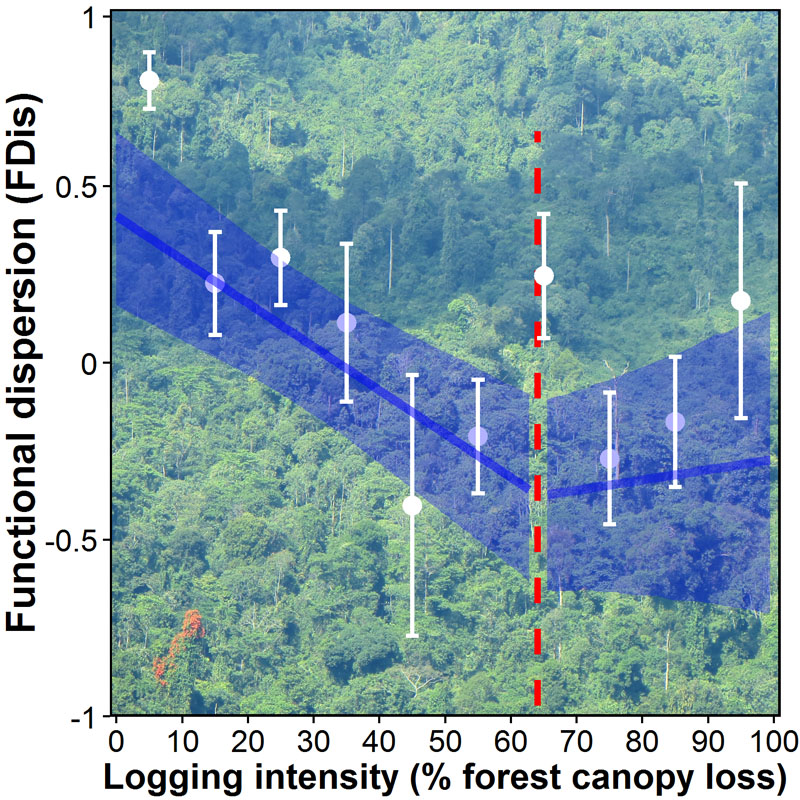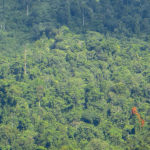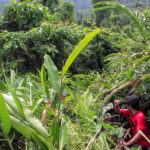New publication: logging of Borneo’s rainforests, the impacts on plant communities
How does logging affect the diversity of rainforest understorey plant communities in terms of functional traits and ancestral relatedness?
Borneo’s tropical lowland rainforests continue to be logged for their timber and cleared for oil palm plantations at alarming rates. As a result, areas that can be considered truly untouched have nearly disappeared. Most of the remaining forest is fragmented into relatively small patches and degraded in habitat quality. This logging and landscape change can reduce the capacity of forests to safeguard native biodiversity and store carbon. However, they can also alter how resilient the forest is to other threats from global environmental change, such as the invasion of introduced plants and climate change. These large changes to the landscape represent a significant risk to biodiversity and to healthy ecosystems, yet the effects of logging on habitat quality in these forests have rarely been explored.
- Old-growth forest canopy. Photo: Timm Döbert
- Old-growth forest understorey. Photo: Timm Döbert
- Disturbed forest canopy in repeatedly logged forest. Photo: Timm Döbert
- Disturbed forest understorey in repeatedly logged forest. Photo: Timm Döbert
In a paper recently published in the Journal of Ecology, we investigated the effects of logging on two aspects of habitat quality – the diversity of functional traits and degree of evolutionary relatedness – for understorey plants from tropical lowland rainforest in Malaysian Borneo. We installed 180 study plots spanning a gradient of logging intensity from near pristine old-growth forest to repeatedly-logged forest, as part of the Stability of Altered Forest Ecosystems (SAFE) project, including the Maliau Basin Conservation Area. Across these plots we sampled and identified 691 plant species and for each we quantified ten plant traits known to respond to landscape disturbance and affect ecosystem functioning.

The relationship between logging intensity and functional dispersion showed a significant logging ‘threshold’ effect at approximately 65% canopy lost.
We found a strong signal of more randomly-assembled communities (i.e. greater dispersion) with higher levels of logging intensity, for both functional traits and degree of relatedness. Most notably, we detected a significant logging ‘threshold’ effect at approximately 65 % forest canopy loss, suggesting a breakdown in the otherwise strong relationship between functional traits and degree of relatedness.
Our study has provided new insight into the myriad of ways that logging can impact on understorey plant communities in tropical rainforests. The work reinforces the message that it is essential to go beyond simple taxonomic measures to understand forest quality change. However, further work will be critical to understand whether the patterns we observed represent a shift into a permanently degraded forest, or whether it is a transient stage on the path towards reassembly of the original forest.
This news item first appeared on the Journal of Ecology blog.
Read more by downloading the paper here.
Timm F. Döbert, Bruce L. Webber, John B. Sugau, Katharine J.M. Dickinson & Raphael K. Didham (2017) Logging increases the functional and phylogenetic dispersion of understorey plant communities in tropical lowland rainforest. Journal of Ecology (Online early; DOI: 10.1111/1365-2745.12794).



